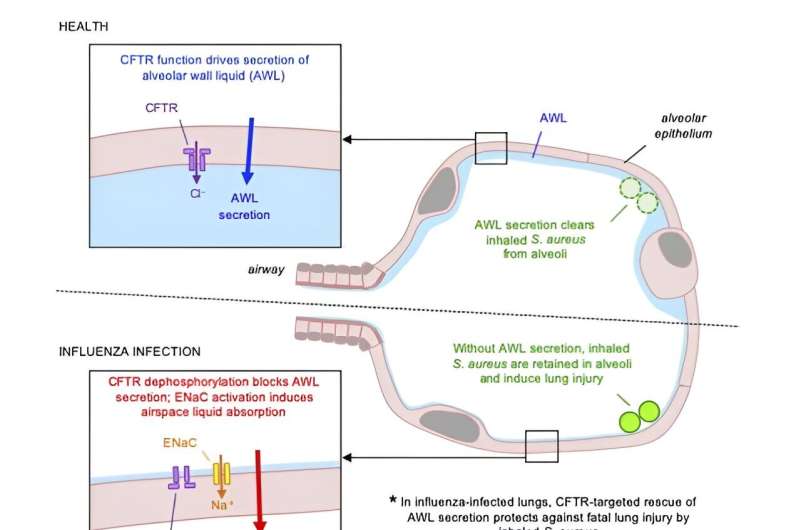Infection
Study among first to show drugs targeting the lung, rather than bacteria, may prevent staph infection in flu patients
Influenza infection (flu) is a major cause of death around the world, especially during years of flu pandemics. People who die of the flu often have a secondary lung infection with Staphylococcus aureus (staph) bacteria that starts a few days after flu infection begins. In new research, a team from Mount Sinai studied how the flu paves the way for staph infection in the lungs. Using mouse models, the researchers found that healthy lungs secrete liquid into their air sacs that prevents a staph infection. The flu blocks this liquid secretion by inhibiting a protein called CFTR, making it possible for staph that are inhaled into the air sacs to stick to the air sac walls, initiate infection, and damage the lungs. Treatment with a CFTR-activating drug, such as ivacaftor, restores liquid secretion in air sacs of the flu-infected lungs and restores the air sacs’ natural protection against staph infection.
The study is published in the Journal of Clinical Investigation.
The researchers applied a method to examine live air sacs of intact, perfused mouse lungs. Mice were untreated or intranasally instilled with the flu at 24 hours before lung imaging. The researchers used a pink dye to view air sac walls and a yellow solution to visualize the air sac liquid. In untreated lungs, loss of fluorescence of the yellow solution over time indicated that the solution was diluted by non-fluorescent liquid, which was secreted into the air sacs by cells that line the air sac walls. By contrast, in lungs infected with the flu, the yellow fluorescence was not lost, signaling that air sac walls failed to secrete liquid. Treatment of the air sac walls of flu-infected lungs with the CFTR-activating drug ivacaftor restarted the liquid secretion. Follow-up studies in mice co-infected with flu and staph showed that the loss of liquid secretion caused inhaled staph to stick to air sac walls, leading to staph infection, lung injury, and death.
The research uncovers how lung air sacs normally protect themselves against staph lung infection and reveals how flu disrupts that protection to make it easy for staph to cause secondary lung infection. The study also explores the possibility of giving ivacaftor to people with flu infection to prevent secondary staph infection, a deadly complication of the flu.
Researchers say these findings support a potential pathway for clinical trials that test whether ivacaftor can prevent secondary staph infection in people with the flu, which is highly feasible since the medication is already in clinical use for both children and adults and has a good record of safety and tolerability.
Speaking about the research, Mount Sinai’s Jaime Hook, MD said, “The combination of flu and staph infections in the lungs is deadly, particularly in young children and older people. Antibiotics don’t always resolve the staph infection because they might be started after the infection is already severe and it’s too late to treat it, or because the antibiotics don’t work if the bacteria are antibiotic-resistant. Our work shows, for the first time, how drugs that target the lung—rather than the bacteria—might treat staph infection in flu-infected lungs. We think that drugs that activate the CFTR protein, like ivacaftor, rescue a critical lung defense mechanism in flu-infected lungs to restore the lung’s natural protection against staph infection. In this way, giving CFTR activator drugs to people with the flu who are at risk for a secondary staph infection might prevent staph infection from initiating, thereby preventing death from flu-staph coinfection.”
Study authors include Jaime Hook, MD, Assistant Professor of Medicine (Pulmonary, Critical Care and Sleep Medicine), and Microbiology, at the Icahn School of Medicine at Mount Sinai; Stephanie Tang, Ph.D. Candidate in the Graduate School of Biomedical Sciences at Icahn Mount Sinai; and other co-authors. Researchers from Yale University School of Medicine and the Vagelos College of Physicians and Surgeons at Columbia University also contributed to the study.
More information:
Stephanie Tang et al, Rescue of alveolar wall liquid secretion blocks fatal lung injury by influenza-staphylococcal coinfection, Journal of Clinical Investigation (2023). DOI: 10.1172/JCI163402
The Mount Sinai Hospital
Citation:
Study among first to show drugs targeting the lung, rather than bacteria, may prevent staph infection in flu patients (2023, August 15)
retrieved 16 August 2023
from https://medicalxpress.com/news/2023-08-drugs-lung-bacteria-staph-infection.html
This document is subject to copyright. Apart from any fair dealing for the purpose of private study or research, no
part may be reproduced without the written permission. The content is provided for information purposes only.

